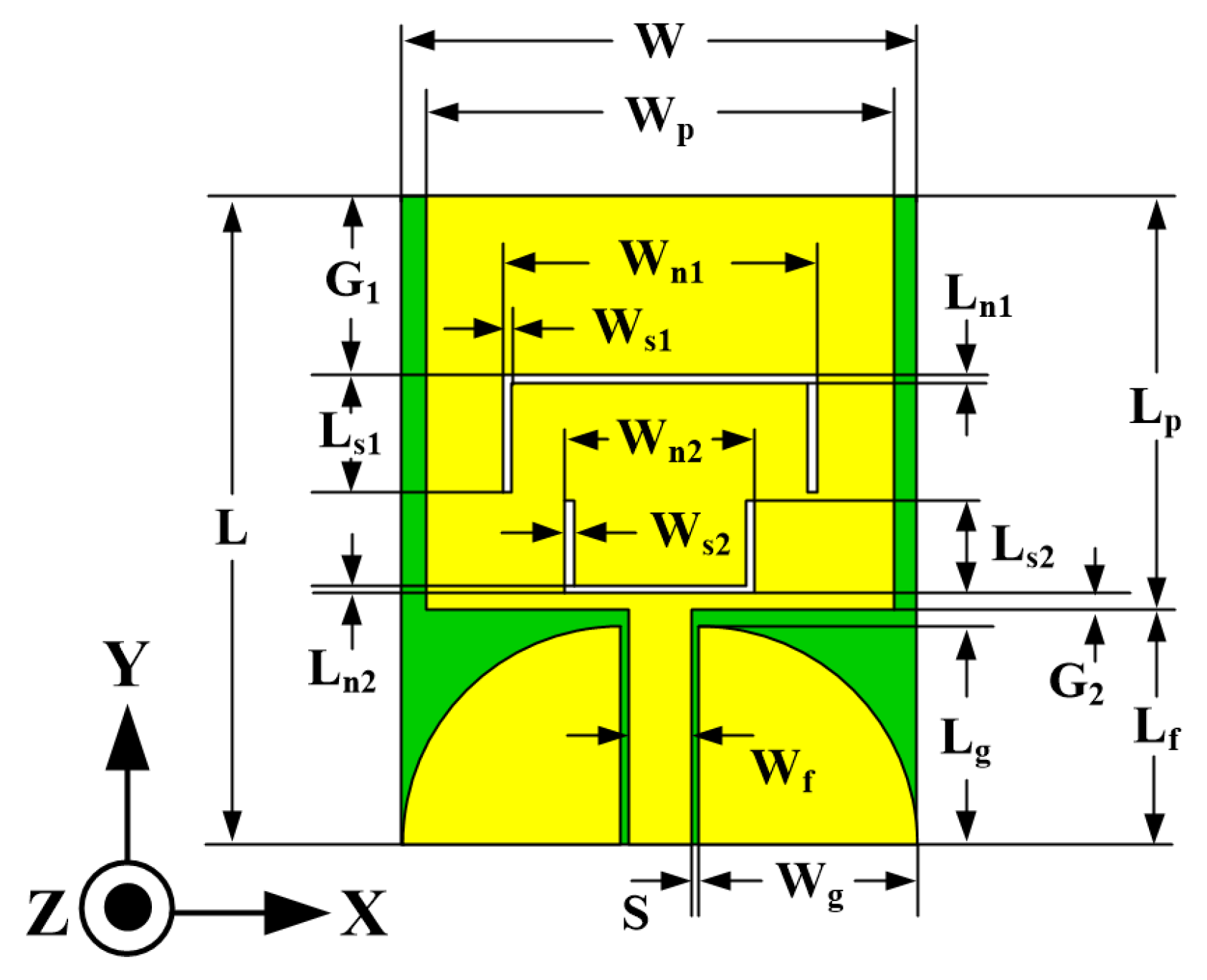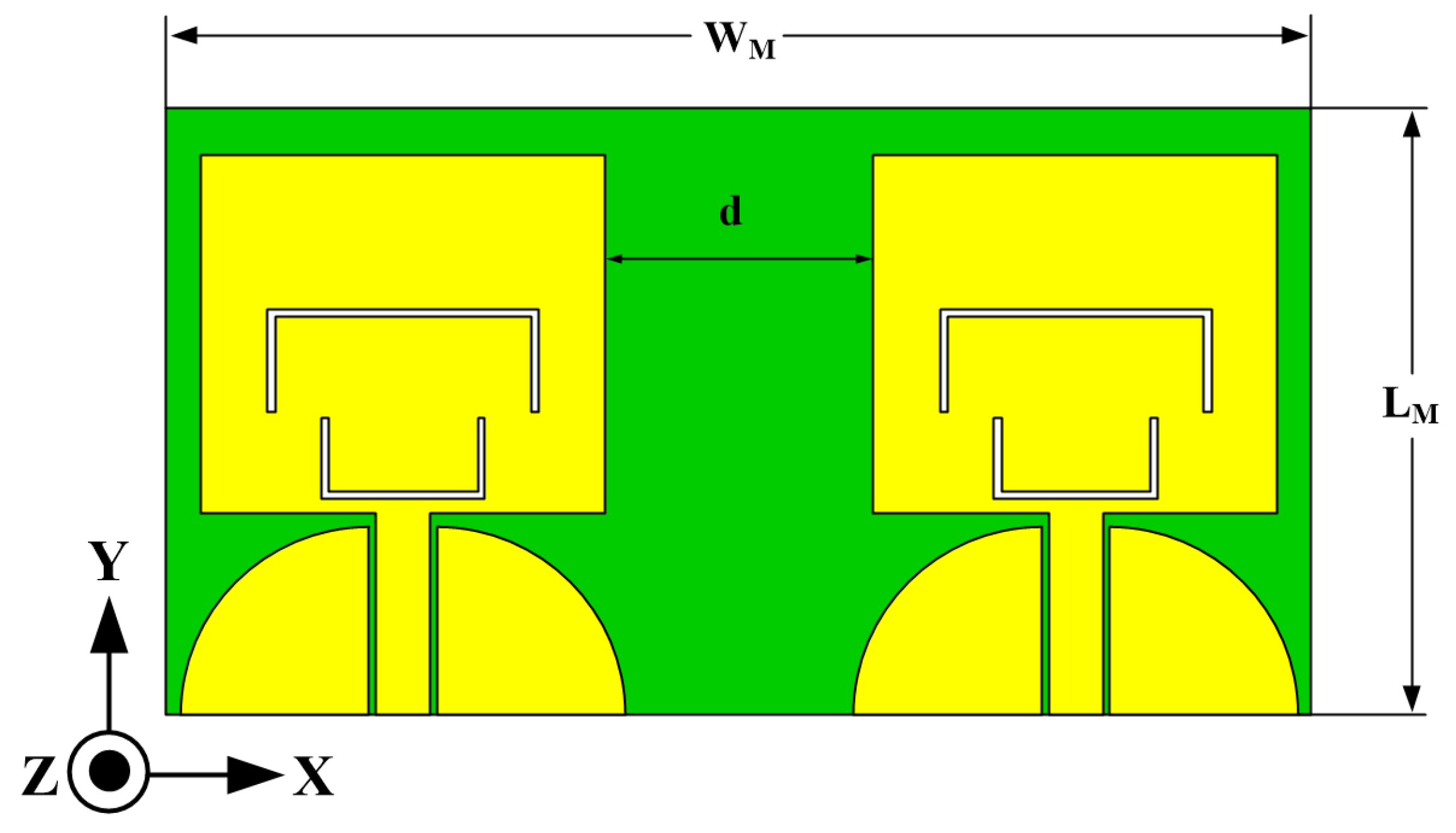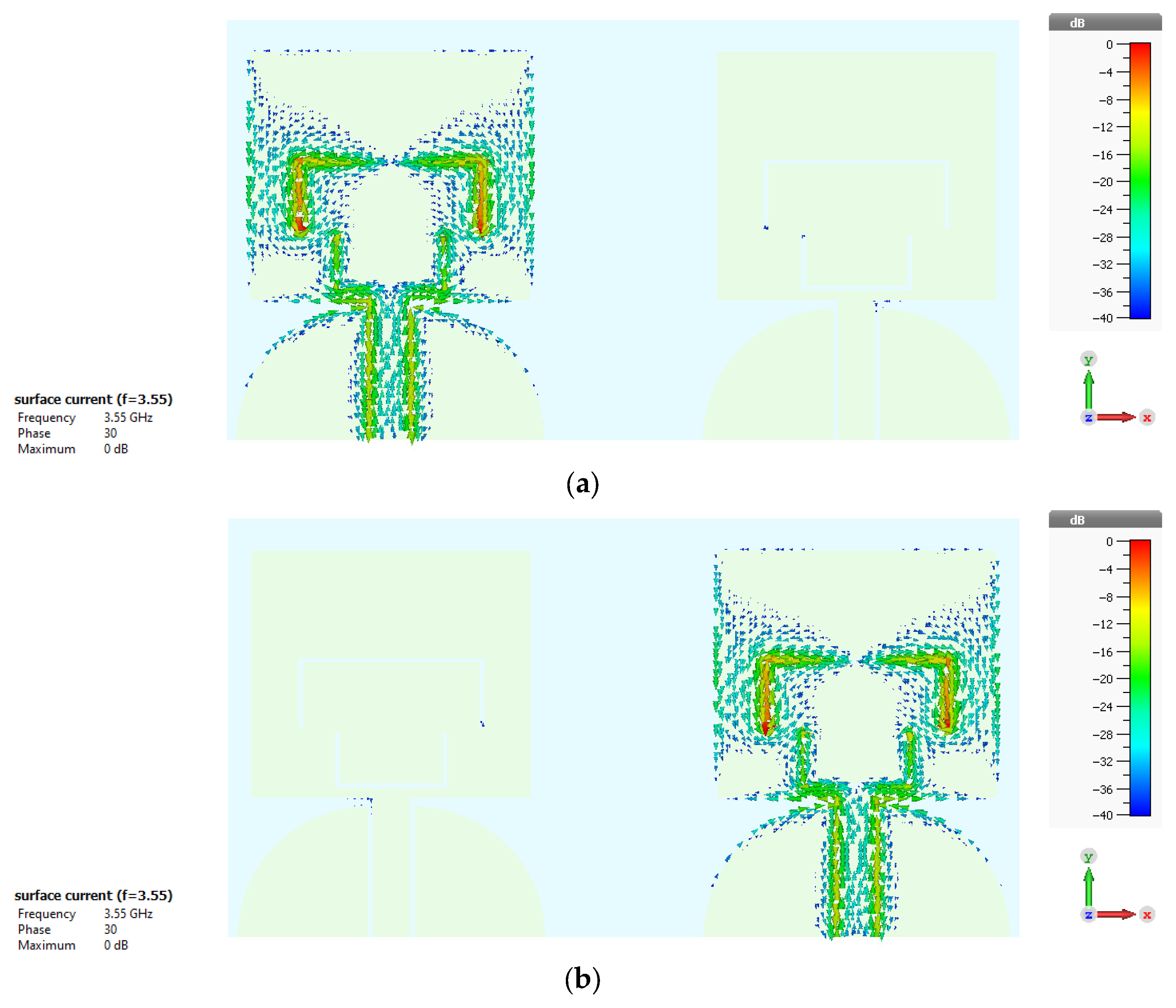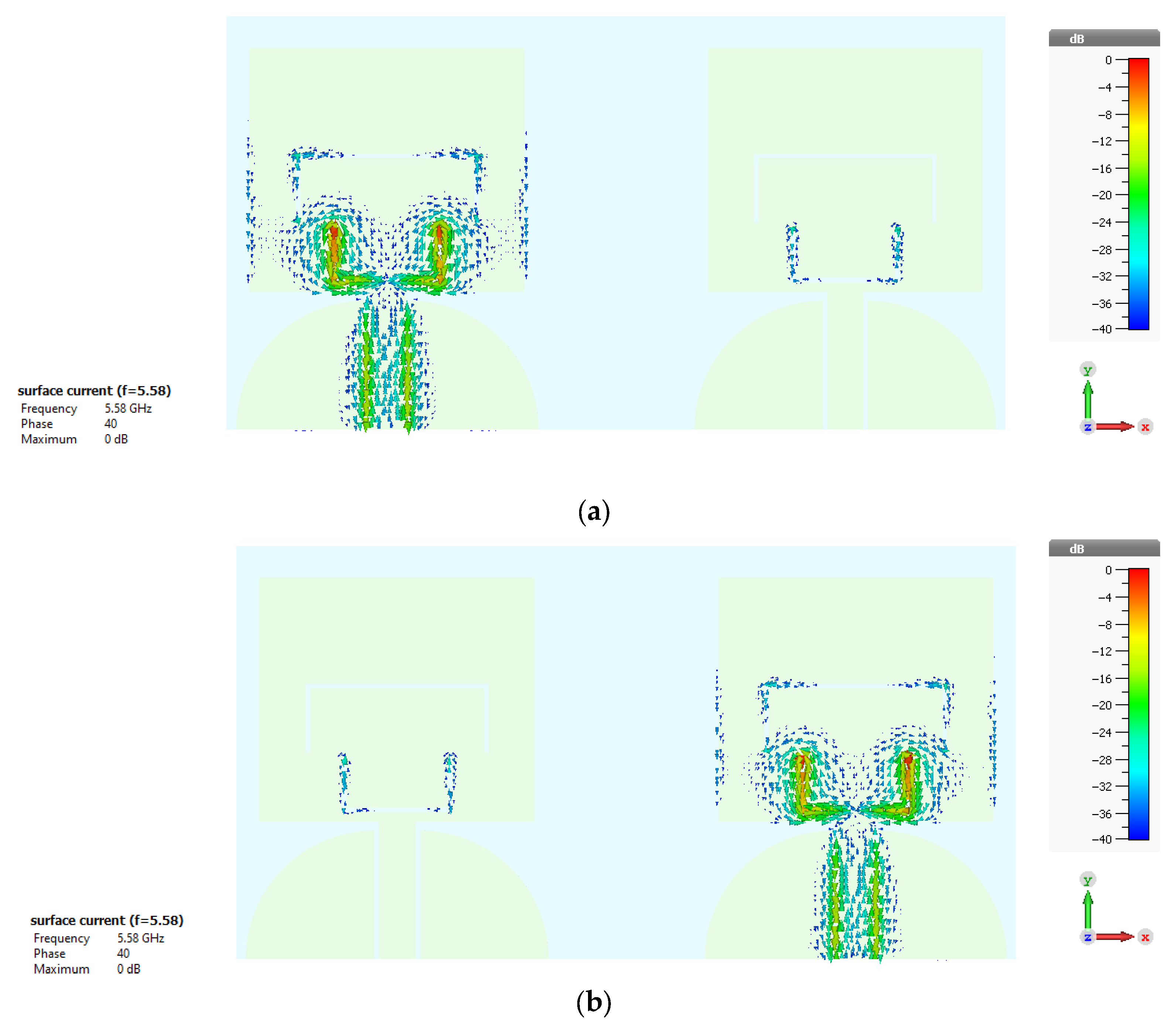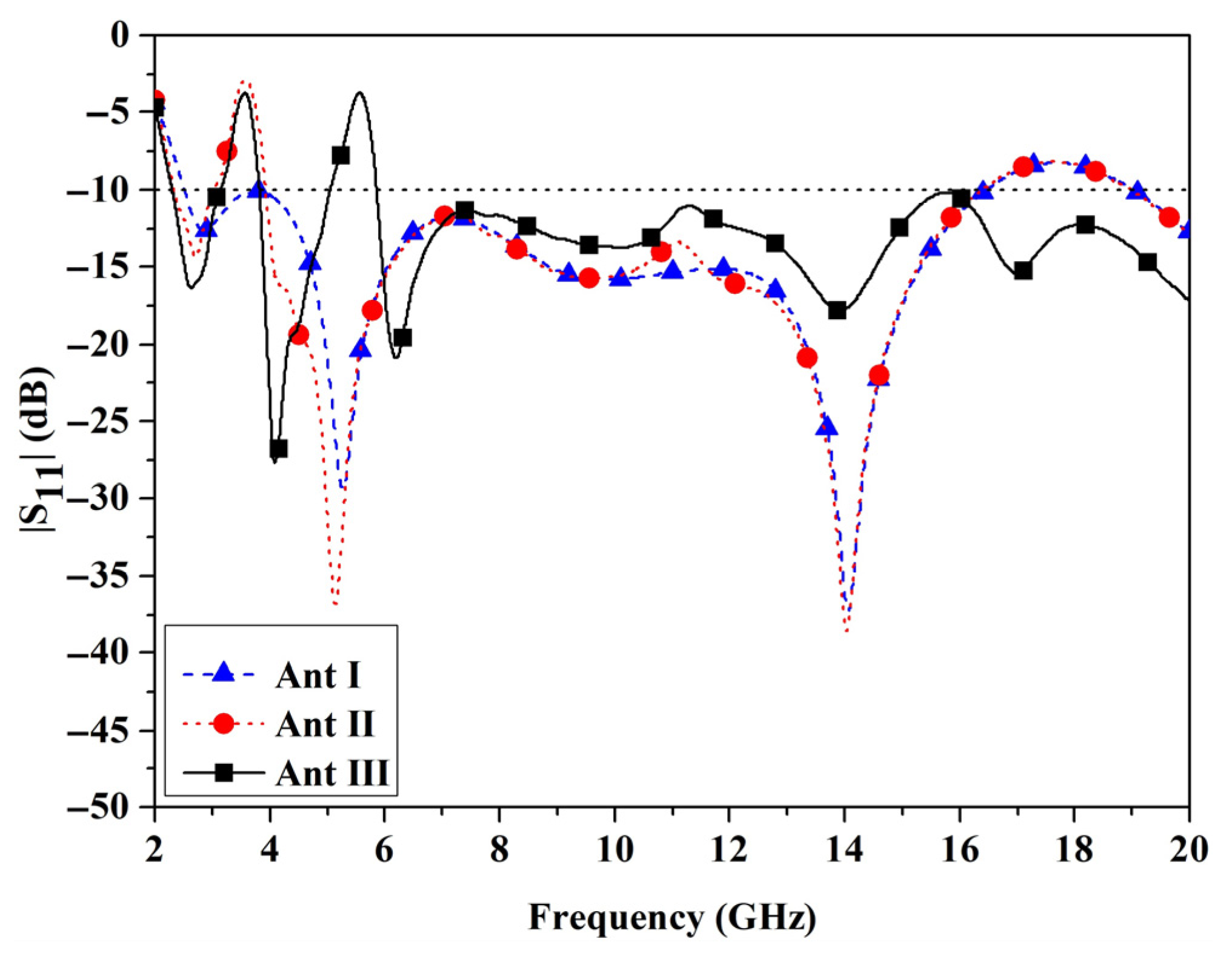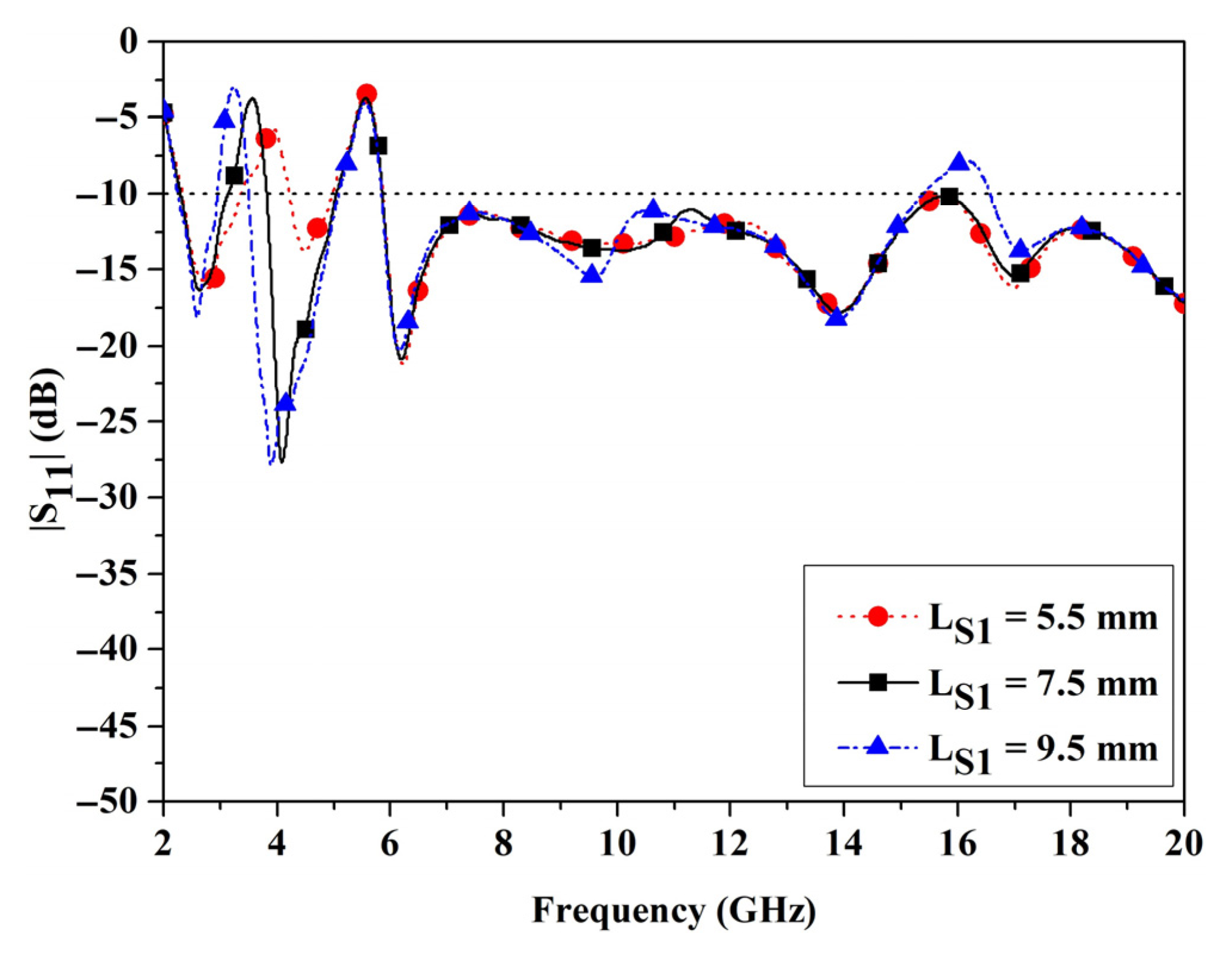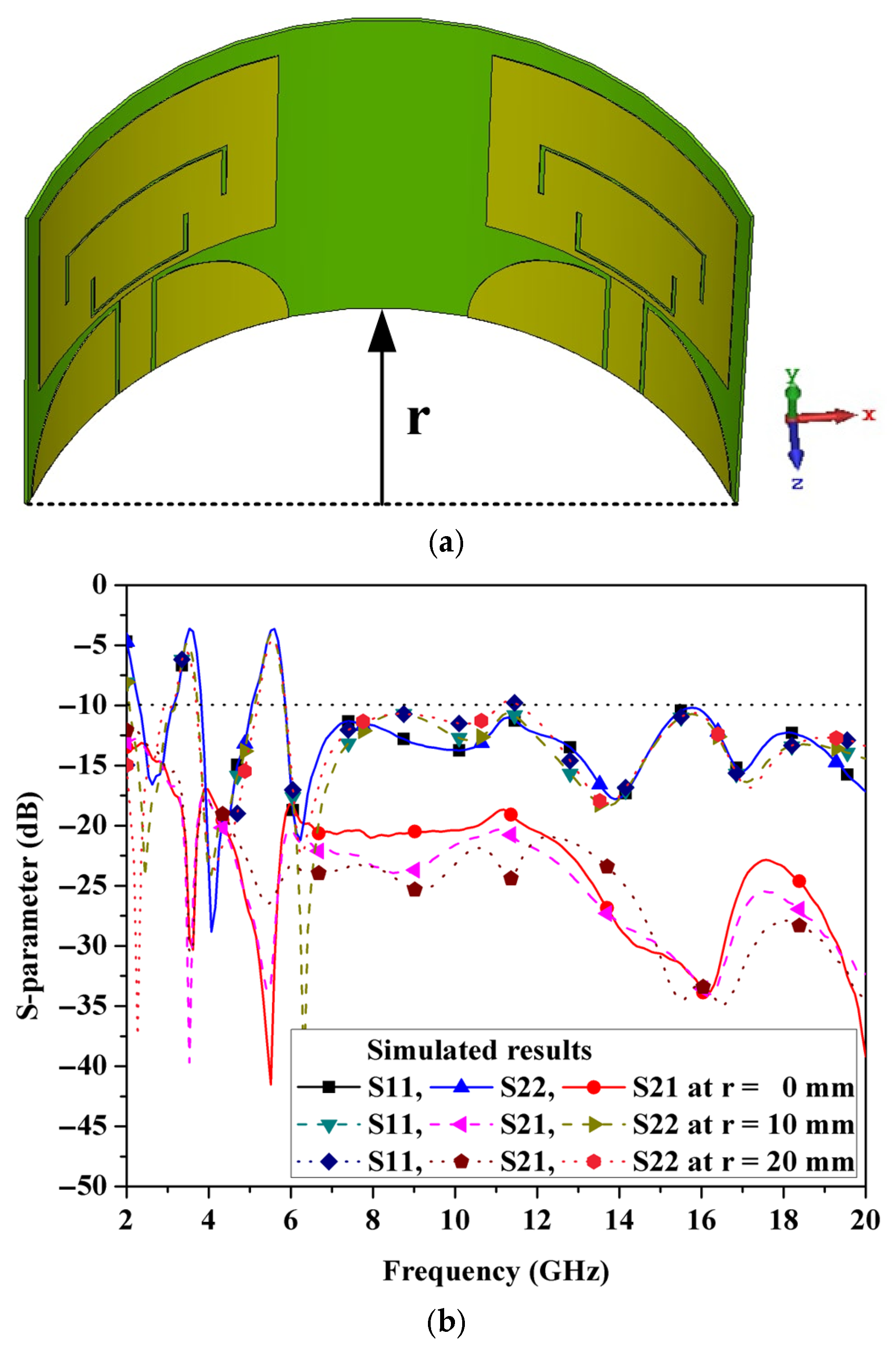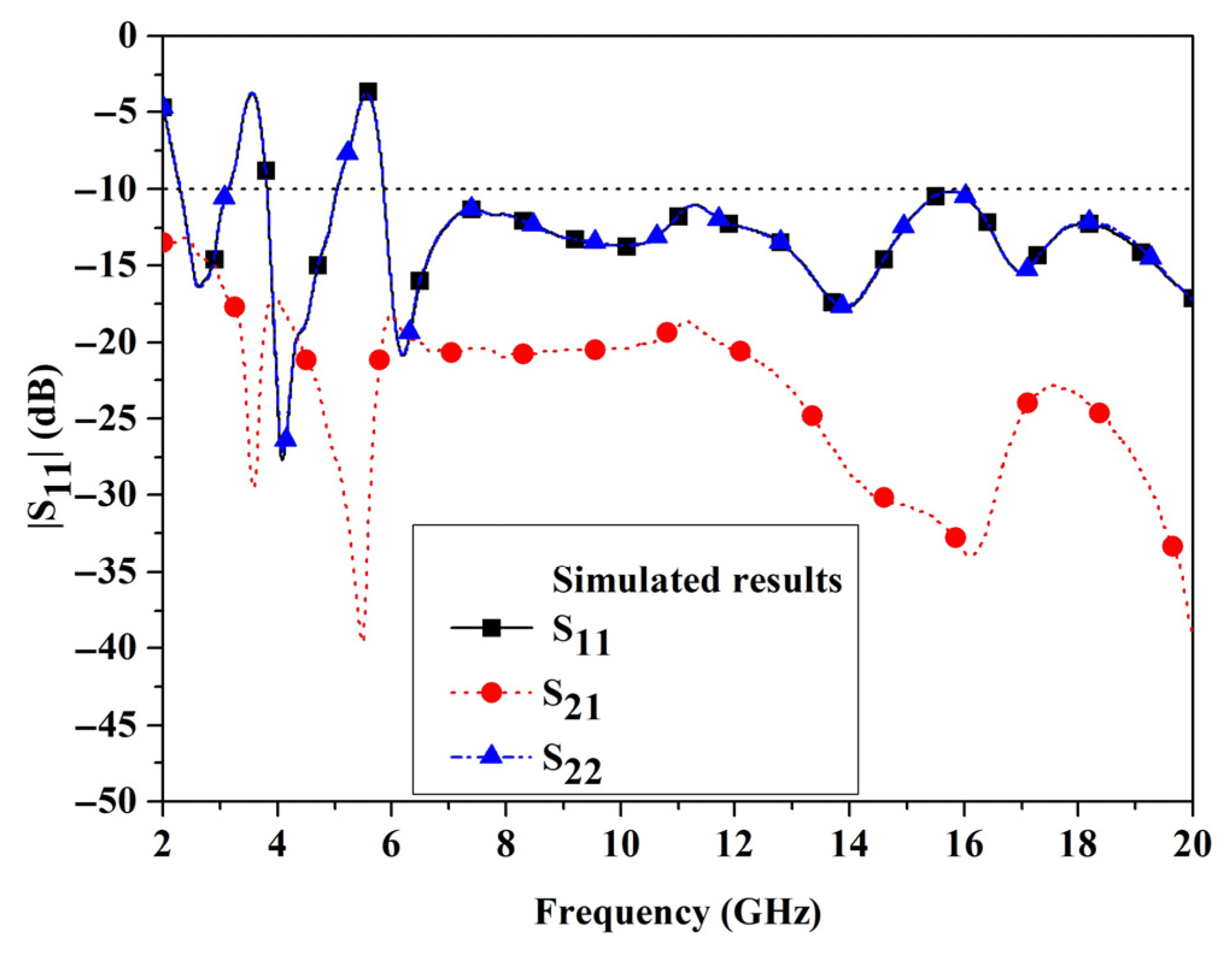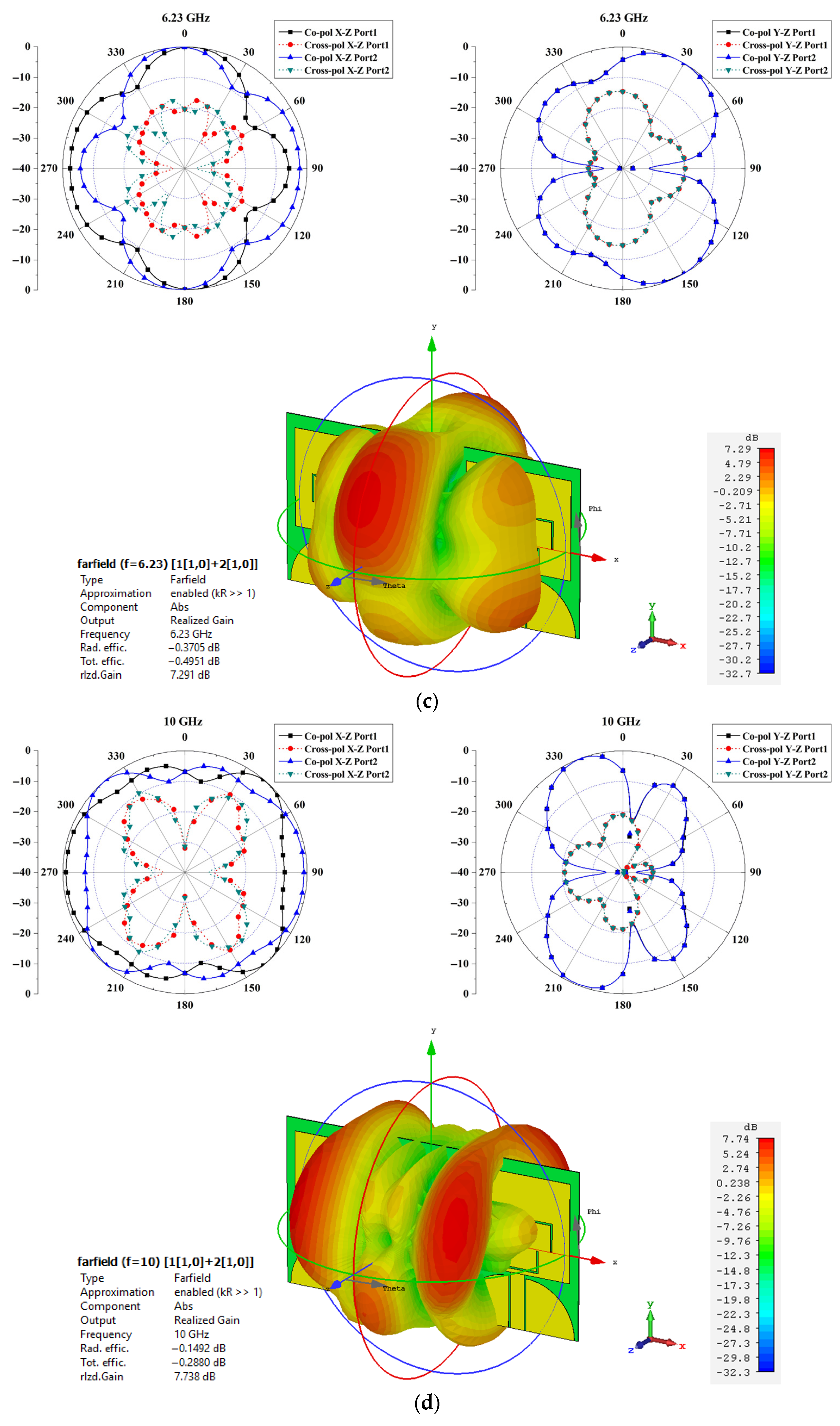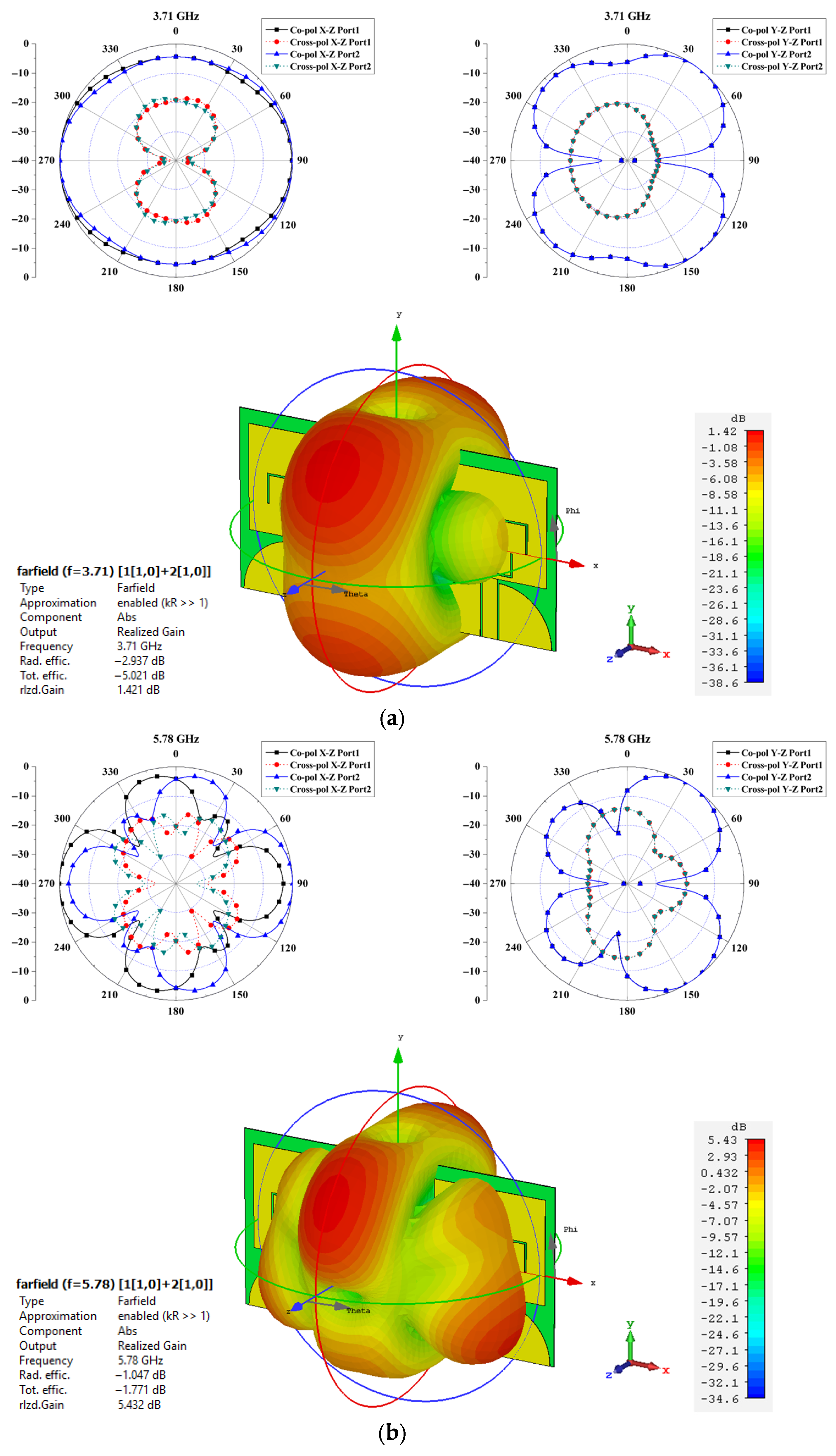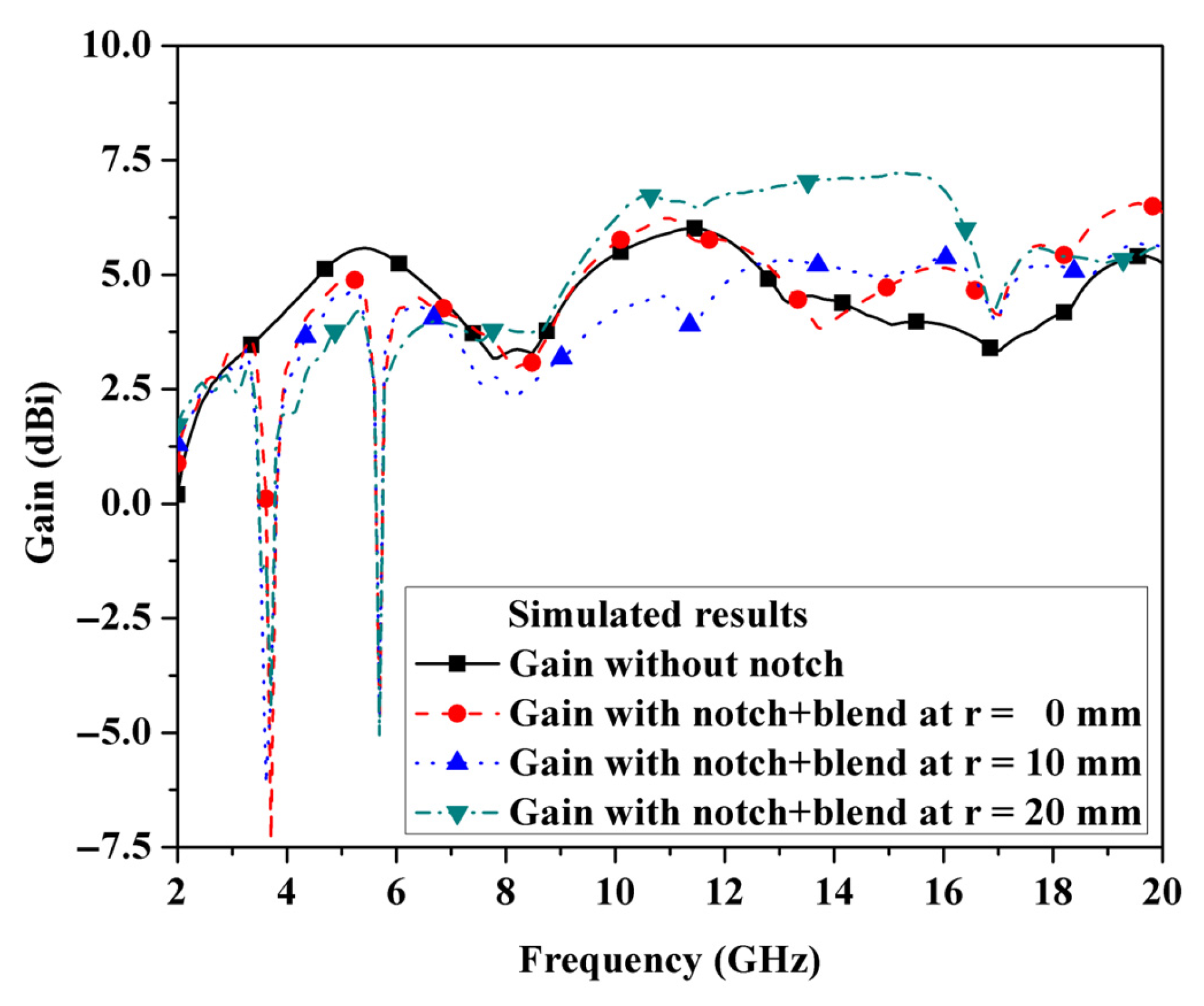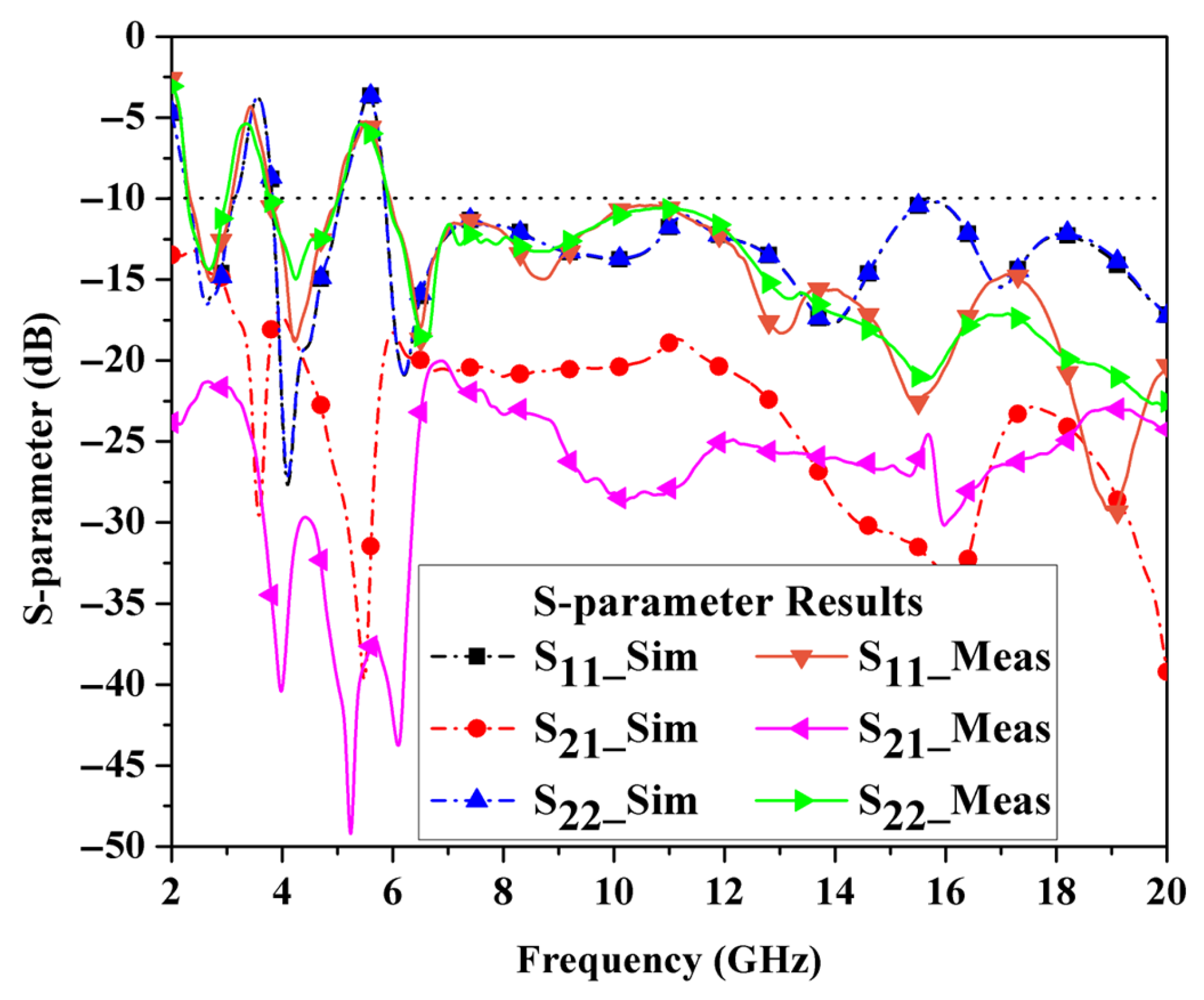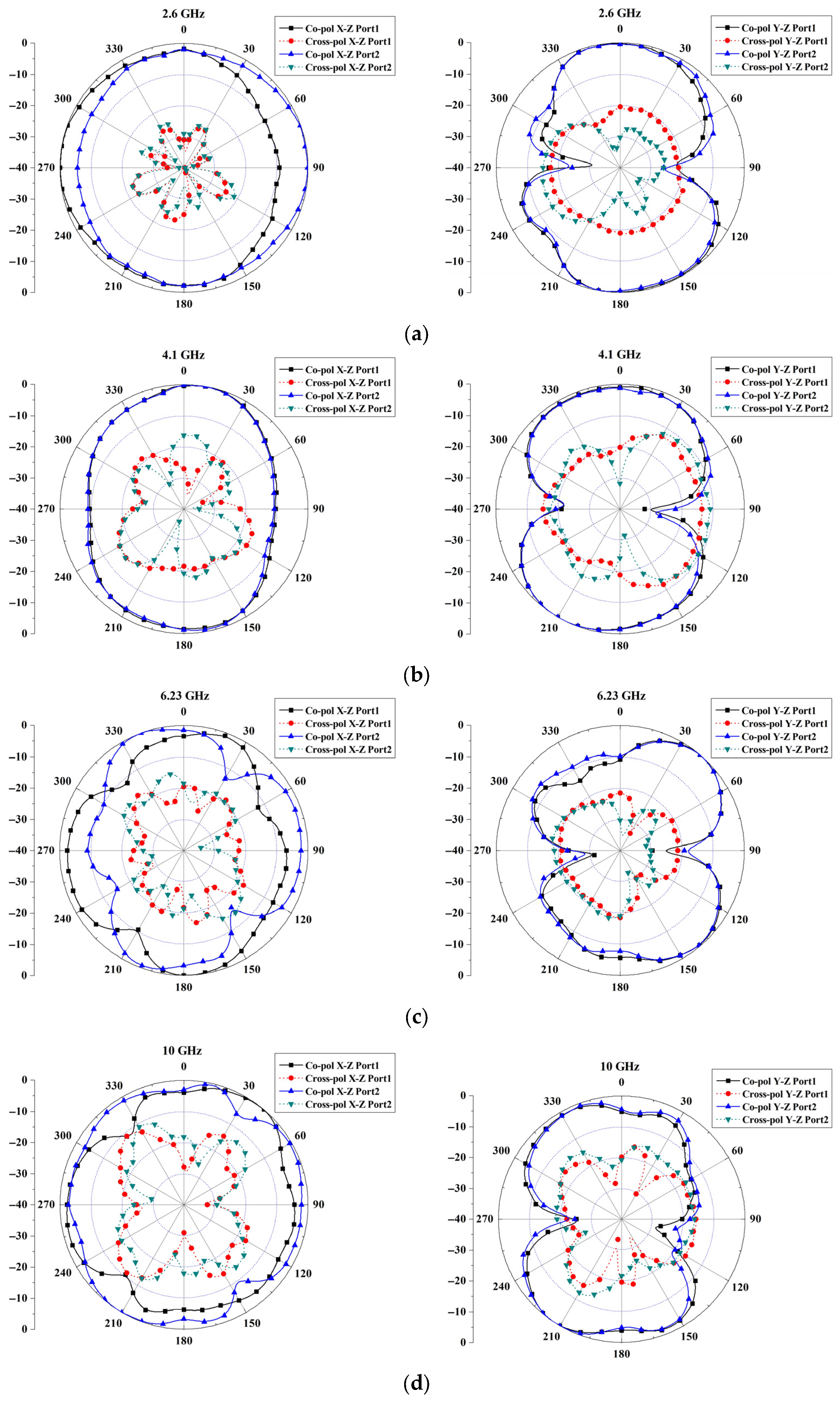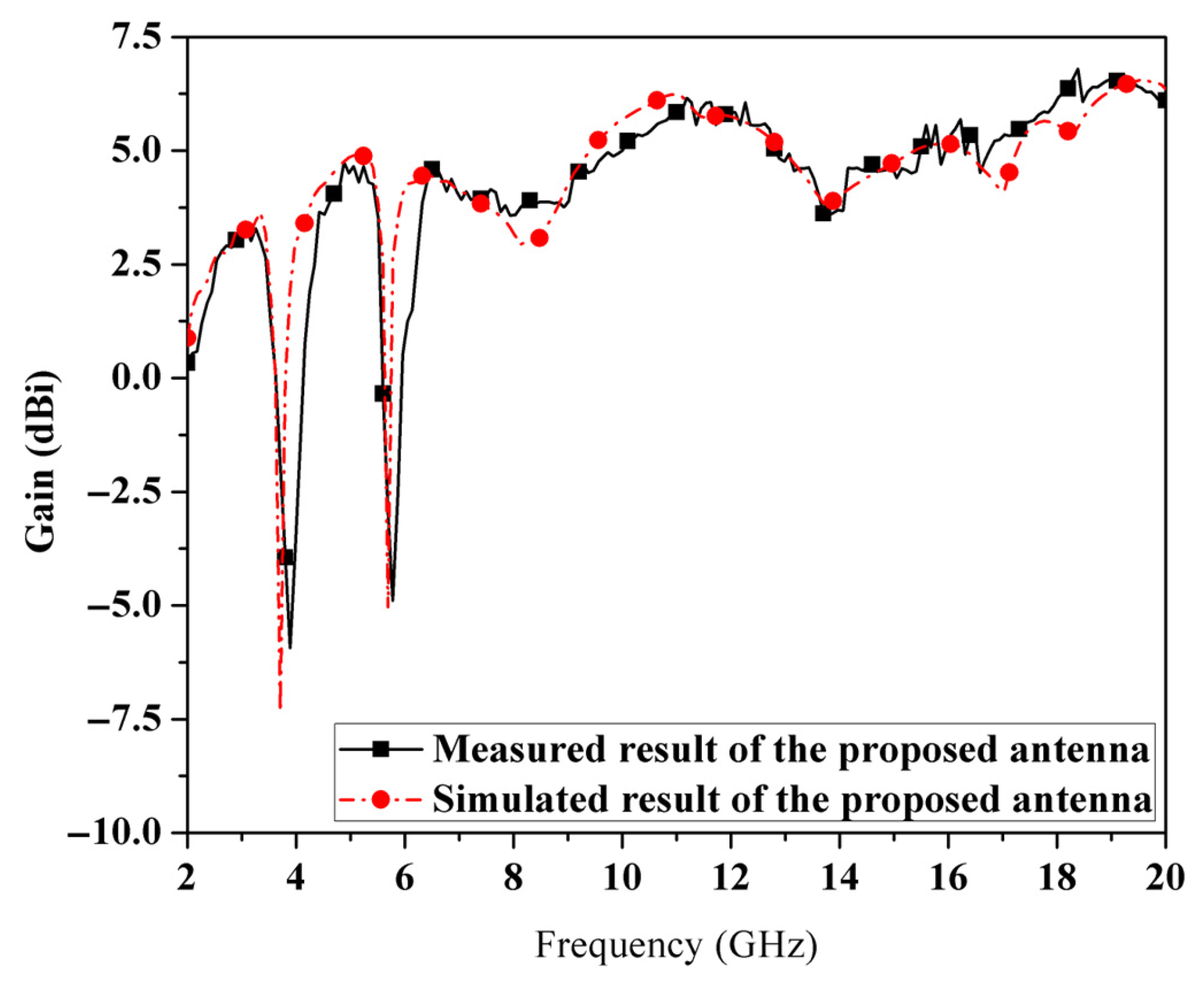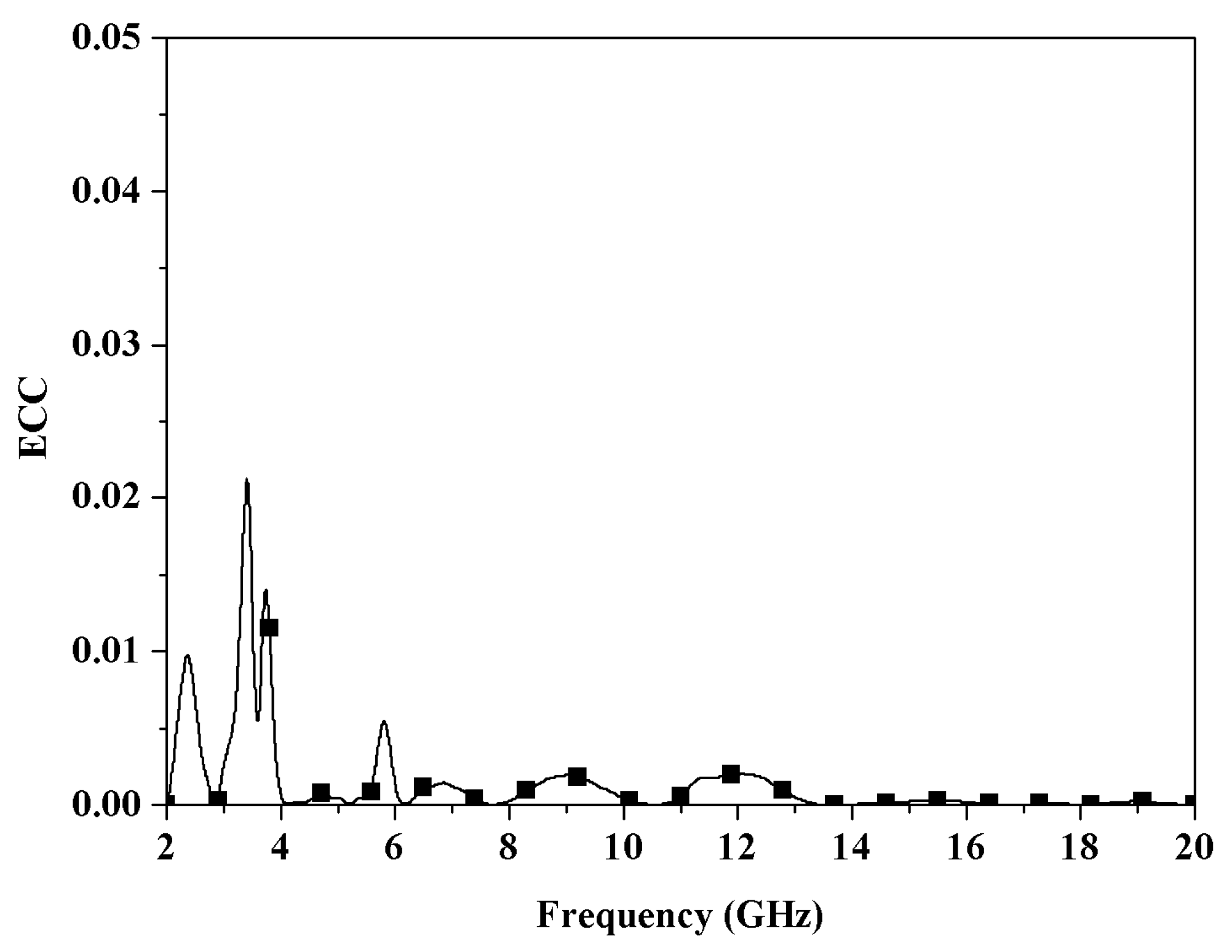1. Introduction
Wireless communication systems have become much more important recently, with several applications necessitating very high-speed data transfer. The Federal Communication Commission (FCC) has permitted the use of unlicensed bands from 3.1 to 10.6 GHz for commercial ultra-wideband (UWB) communication [
1,
2,
3,
4,
5,
6], resulting in significant interest in UWB technology due to its benefits such as high accuracy, elevated data rates over short distances, and minimal power consumption. However, it faces some defects in reliability and a fading signal due to multipath interference. MIMO technology is commonly used to reduce multipath fading and improve data transmission quality [
7,
8,
9,
10,
11,
12]. Therefore, MIMO technology has been combined with a UWB antenna. The small size and low mutual coupling of a UWB MIMO antenna should be considered in its design. Numerous methods have been suggested for UWB MIMO antennas to reduce mutual coupling [
13,
14,
15,
16]. Parasitic fragment-type elements between the MIMO antenna elements that produce good isolation were proposed in [
13]. This provides design liberty; nevertheless, the optimization procedure is complex and constrained to a restricted frequency range of 2.45 GHz. In [
14], researchers described embedding a three-level stepped slot on the central ground of a tiny tapered slot MIMO antenna to enhance isolation. Although the design on FR4 is compact and structurally simple in [
14], its efficiency may be compromised due to the properties of the FR4 material. The authors of [
15] used the CSRR structure to boost the isolation of the UWB diversity antenna. The applied CSRR structure and inverted-L stubs effectively minimize size and enhance isolation; nevertheless, the complexity of the structure may adversely impact the radiation pattern. The mutual coupling of the MIMO antenna was decreased, as described in [
16], by placing an F-shaped stub on the ground plane. The F-shaped stub used on a common ground offers excellent isolation (
S21 < −20 dB); yet, it remains comparatively big relative to other designs and is unsuitable for flexible applications.
In addition, the frequency range of UWB systems produces interference with WiMAX at 3.3–3.7 GHz and with WLAN networks between 5.15 and 5.825 GHz. To eliminate interference, a superior antenna for UWB MIMO systems must attenuate frequencies in other application bands while preserving the benefits of the UWB MIMO antenna. Numerous studies on UWB MIMO antennas have utilized a variety of techniques to attempt to develop UWB MIMO antennas with band-notched features [
17,
18,
19,
20,
21,
22,
23,
24,
25]. A small UWB MIMO antenna with a T-shaped ground stub inserted to diminish mutual coupling and parasitic metal strips to notch the WLAN band was presented [
17]. The placement of a T-shaped stub beside a parasitic band facilitates a compact configuration and accurate filtration of WLAN signals inside the 5.15–5.85 GHz spectrum, providing a bandwidth coverage of 3–10.6 GHz. However, the structure continues to depend on via holes, which might be intricate to produce. In [
18], the authors describe a small band-notched stepped slot UWB MIMO antenna via differentially U-shaped microstrip feed to a half-wavelength resonant stub. Adjusting the stub length to regulate the notch frequency facilitates versatile tuning, while the incorporation of several slots ensures superior isolation. Nonetheless, the antenna’s total dimensions remain somewhat substantial. In [
19], a quad-element UWB MIMO antenna etched with four crescent ring-shaped resonant slots on the radiator for notch frequency and reducing mutual coupling based on EBG structure was proposed. The application of a modified EBG structure, including a crescent-shaped resonant slot, enhances isolation and produces a pronounced notch, while preserving high gain and efficiency, making it appropriate for portable devices. Nonetheless, the structure remains intricate owing to the utilization of many vias, rendering it challenging to fabricate, particularly on a small scale. In [
20], the authors describe inserting U-shaped and L-shaped slots into the UWB MIMO antenna to notch the WiMAX spectrum. This structure attains significant isolation (−30 dB) and effectively filters the WiMAX spectrum by meticulous slot design. However, a comprehensive examination of its impact on the radiation pattern, which is essential for MIMO systems that need superior link quality, is lacking. In [
21], the authors proposed a tapered fed compact UWB diversity antenna using L-shape slit notch dual frequency. This antenna attains dual-band notch and mutual coupling below −22 dB within a compact dimension (18 × 34 mm
2), making it appropriate for portable electronics, but the radiation patterns are distorted owing to the antenna’s asymmetry. Loading a trident-shaped strip for a dual-band notch of a UWB MIMO antenna for portable applications in devices was studied [
22]. This structure is effective across the full UWB spectrum (3.1–11.8 GHz) owing to the integration of multiple notch mechanisms and isolation in both low and high bands, excluding the specific notch band. However, this increases design complexity, and employing multiple fixed notch structures may reduce flexibility when the interferer band varies. The twin-band-notched UWB MIMO antenna design for surface penetrating applications in [
23] rejected two bands by incorporating two symmetrical strips and three interconnected circles of equal radius inside the radiator. Although the antenna was created for surface-penetrating applications with an extensive bandwidth (1.57–12.4 GHz) and tested on actual materials, it possesses a considerable size (56 × 32.47 mm
2) and utilizes FR4 material, potentially constraining gain and efficiency in high-sensitivity applications or portable devices with spatial limitations. In [
24], a UWB MIMO antenna was designed for dual frequencies by using open-ended quarter-wavelength slots on the radiator and positioning an I-shaped stub on the ground plane to mitigate mutual coupling. This antenna is designed to filter three frequency bands (WiMAX, WLAN, X-band) using quarter-wavelength slots and an I-shaped stub to minimize coupling. Nonetheless, the isolation and
ECC are mild (−15 dB, 0.2), perhaps inadequate for high-density MIMO systems. In [
25], the authors investigated a small four-port UWB MIMO antenna that uses two shared radiators for a dual-band notch and the meandering line stub to achieve minimal mutual coupling. The integration of a combined radiator and a meandering stub enhances the efficiency of this four-port configuration for bandwidth and isolation (≤−22 dB). Nonetheless, it covers a substantial area (48 × 48 mm
2) and has not been evaluated in practical situations, including multidirectional interference or cross-polarization. Each study has distinct benefits; yet, limits regarding size, complexity, and practicality need additional consideration.
Despite ongoing advancements in UWB MIMO antennas regarding notch filtering and mutual coupling suppression, significant deficiencies remain, including structural complexity, flexibility in notch frequency, substantial physical dimensions, and insufficient critical evaluation and testing of MIMO systems in practical environments.
In addition to advancements in UWB MIMO development, recent research has shifted towards conformal antenna technologies that incorporate radiating elements into curved or non-planar structures, preserving aerodynamic and structural integrity. The concept has been expanded to include conformal reflectarrays, transmitarrays, and metasurfaces, providing lightweight, low-profile, and highly directed radiation systems. In [
26], it is proposed that the optically transparent conformal reflectarrays utilizing indium tin oxide (ITO) rings and patches exhibit extensive phase coverage, minimal return loss, and improved multi-angle scattering in the X-band, rendering them appealing for stealth and target echo manipulation. Moreover, conformal transmitarrays demonstrate that effective phase control and beam steering can be accomplished on curved surfaces [
27], while conformal metasurface arrays utilizing waveguide feeding and semi-analytical dipolar modeling offer systematic frameworks for radiation synthesis with diminished feed complexity [
28]. These improvements collectively broaden the potential applications of antennas in communications, radar, stealth technology, and electromagnetic compatibility, hence inspiring the creation of next-generation compact and multifunctional UWB MIMO antennas.
The study proposes and examines an antenna with dual-band-notched features for WLAN and WiMAX communication networks. It is created with a simple construction, a flexible framework, and minimal physical dimensions. This flexibility and robustness are achieved by the utilization of Mylar® polyester film, which provides advantages such as strength, durability, lightweight characteristics, flexibility, and exceptional resistance to moisture, chemicals, and extreme temperatures. The antenna has two rectangular channels and a double-quarter-circular ground plane, supplied by a coplanar waveguide, to provide optimal impedance matching on the UWB frequency spectrum and robust MIMO performance. Two U-shaped slots are included in the radiator to provide dual-band-notched features, with one inverted U-shaped slot designated for notched frequency response within the 3.3–3.7 GHz range (Wi-MAX band) and another allocated for notched frequency response within the 5.1–5.8 GHz range (WLAN band). The CST microwave simulation program was employed to execute and enhance the planned antenna. The simulation and measurement findings are ultimately analyzed.
3. Simulation Results
The antenna design on Mylar® polyester film had a dielectric constant εr = 3.2, a thickness h = 0.3 mm, and a size of 85 × 45 mm2. The antenna was simulated using CST microwave software. In this section, various parametric analyses of the suggested antenna, including the S-parameters, radiation patterns, peak gain, and ECC, are shown and discussed.
3.1. S-Parameters of the Simulation
In this section, we study the simulation results of the characteristics of S-parameters, including the reflection coefficient (S11 and S22 parameters) and the transmission coefficient (S21 parameter) of the proposed antenna.
Figure 5 demonstrates the development of the designed antenna from Antenna I to Antenna III. Antenna I is a UWB, Antenna II is a UWB with a single-band notch, and Antenna III is a UWB with dual-band notches.
Figure 6 depicts the
S11 parameters of Antennas I, II, and III. For Antenna I, the wideband impedance matching was responsible for −10 dB encompassing the entire UWB spectrum from 3.1 to 10.6 GHz (2.28 to 20 GHz). The impedance bandwidth of Antenna II was lower than −10 dB over the entire UWB band, except for the frequency range between 3.3 and 3.7 GHz (WiMAX band). The band was rejected by inserting an inverted U-shaped slot on the radiator of Antenna II. In Antenna III, inserting a U-shaped slot below the inverted U-shaped slot on the radiator rejected the impedance bandwidth at the dual-frequency range of 3.3–3.7 (3.12–3.85) GHz and 5.1–5.8 (5.02–5.84) GHz (WLAN band), while the remaining UWB band had a lower -10 dB impedance bandwidth. This indicates that the designed antenna can reject narrowband interference while maintaining acceptable matching impedance characteristics throughout the UWB band.
Additionally, the antenna elements influencing the notch frequencies and MIMO features were examined. The antenna components influencing the notch frequency in the WiMAX band included
Ls1 of the inverted U-shaped slot, whereas element
Ls2 of the U-shaped slot was used to attenuate the WLAN band frequency.
Figure 7 illustrates the
S11 findings obtained by modifying
Ls1 to provide a band-notched response within the spectrum of 3.3–3.7 GHz. As
Ls1 increases from 5.5 mm to 9.5 mm, the modified findings of the element revealed that, as the size climbed, the first band-notched response shifted to lower frequencies.
Figure 8 depicts the
S11 outcomes of modifying
Ls2 to achieve a band rejection at the notched frequencies of 5.1 and 5.8 GHz. As
Ls2 is incrementally increased from 5 mm to 7 mm, the second band-notched response is shown to shift to lower frequencies. The outcomes of modifying both components are shown in
Figure 7 and
Figure 8. The simulation findings indicate that the modification of the notch features only influenced the frequency band under investigation, while the other intended working band retained its original properties. Moreover, modifying the notch components of one band did not influence the notch frequencies of the other bands.
Finally, the MIMO characteristics are examined by altering the distance (
d).
Figure 9 illustrates the
S21 parameters for adjusting the distance (
d) between the two adjacent antennas as shown in
Figure 2. The results of increasing the distance (
d) from 16 mm to 20 mm demonstrate that as the distance increased, the transmission coefficient level decreased. The optimal distance
d was 20 mm, which provided a mutual coupling of less than −14 dB.
Figure 10a depicts the conformal UWB MIMO antenna configuration with the bending parameter
r, representing the extent of curvature when affixed to cylindrical surfaces. To assess the resilience of the suggested design under varying bending situations, the S-parameter responses for
r = 0, 10, and 20 mm are illustrated in
Figure 10b. The impact on the reflection coefficients (
S11 and
S22) is depicted in
Figure 10b. The reflection coefficients for both ports consistently remain below −10 dB throughout the majority of the UWB working band, hence affirming effective wideband impedance matching. When the antenna is flat (
r = 0 mm), pronounced notch bands manifest around 3.71 GHz and 5.78 GHz, where
S11 and
S22 increase sharply above −5 dB, signifying a deliberate impedance mismatch that attenuates energy at these frequencies. As the antenna curvature increases to
r = 10 mm and
r = 20 mm, the overall impedance matching experiences modest perturbations, accompanied by tiny frequency shifts and fluctuations in notch depth. Nonetheless, the notches remain distinctly visible, indicating that the dual-notch mechanism is resilient to conformal bending. The transmission coefficient (
S21) demonstrates inter-port isolation consistently below −15 dB throughout the majority of the UWB band for all curvature scenarios, signifying minimal mutual coupling appropriate for MIMO functionality. At the notch frequencies of 3.71 GHz and 5.78 GHz,
S21 exhibits a further decline (becoming more negative), indicating that the antenna not only mitigates radiation but also improves port isolation at the notched bands. This is advantageous in dual-port operation, as it diminishes the likelihood of interference coupling between parts at the rejected channels.
Therefore, it can be observed that although slight frequency shifts and variations in impedance matching occur with increasing curvature due to bending, the dual-notch characteristics at 3.71 GHz and 5.78 GHz, as well as the port-to-port isolation, remain preserved, confirming the antenna’s stable performance under mechanical deformation.
The optimum parameter values derived from prior studies are used to simulate the antenna characteristics, displayed in
Figure 11.
Figure 11 illustrates the reflection coefficients for port 1 (
S11) and port 2 (
S22), as well as the coefficient of transmission (
S21) of the presented antenna. The comparison of the reflection coefficient features of
S11 and
S22 produced similar results. Both values were below −10 dB across the UWB spectrum, except for the notched frequency ranges for WiMAX and WLAN, whereas the transmission coefficient (
S21) demonstrated low mutual coupling under −16 dB throughout the full UWB band. The MIMO performance of the antenna was improved by modifying the distance (
d) between the antenna components.
3.2. Radiation Pattern of the Simulation
This section assesses the radiation attributes of the suggested UWB MIMO antenna for wireless communication systems across multiple frequencies. Radiation patterns immediately indicate the antenna’s efficacy in consistently transmitting and receiving signals across various directions, a crucial element for assuring dependable MIMO performance and spatial signal diversity.
Figure 12a–d displays the simulated two-dimensional and three-dimensional radiation patterns of both co-polarization and cross-polarization components in the
X–
Z and
Y–
Z planes at four specified frequencies: 2.6 GHz, 4.1 GHz, 6.23 GHz, and 10 GHz. The simulations were performed by energizing one port at a time, while the other was terminated using a 50-ohm load to isolate the behavior of each particular port. This port-switching technique facilitates the evaluation of radiation symmetry and consistency, essential for reliable MIMO functionality. At low and mid frequencies (2.6 and 4.1 GHz), as seen in
Figure 12a,b, the radiation patterns exhibited consistency and symmetry between both ports, indicating strong port-to-port similarity. The
X–
Z plane had omnidirectional properties, advantageous for uniform coverage, but the
Y–
Z plane revealed bidirectional characteristics, which may enhance spatial diversity.
Figure 12c,d depicts the radiation patterns at higher frequencies (6.23 and 10 GHz). Comparable symmetry and consistency were observed; however, increasing distortion in pattern shape occurred owing to the appearance of higher-order electromagnetic modes at increased frequencies. The results indicate that the suggested antenna sustains favorable omnidirectional and bidirectional radiation patterns over the majority of the UWB spectrum, guaranteeing effective spatial coverage and variety. The observed distortion at elevated frequencies suggests a possible constraint in pattern stability that must be considered in high-frequency or high-density implementations.
Figure 13a illustrates that the radiation patterns at 3.71 GHz exhibit an almost omnidirectional configuration in the
X–
Z plane and a bidirectional characteristic in the
Y–
Z plane. Co-polarization predominates over cross-polarization, signifying steady radiation with high polarization clarity. It is important to note that the gain levels at the boresight direction (0°) are below −5 dB for both planes. The considerable decrease in radiation intensity immediately indicates the suppression effect of the designed notch band at this frequency, hence reducing radiated energy and providing successful interference mitigation. At 5.78 GHz, as depicted in
Figure 13b, the antenna demonstrates complicated multi-lobed radiation patterns in both the
X–
Z and
Y–
Z planes because of the activation of higher-order modes. Similarly to the 3.71 GHz situation, co-polarization continues to dominate, although cross-polarization becomes marginally more prominent. The boresight direction demonstrates a gain level below −5 dB, confirming that the antenna efficiently attenuates radiated power at the notched frequency. This confirms that the notching technique effectively diminishes unwanted radiation in the primary direction, thereby ensuring efficient rejection of potential interference sources, including WLAN networks at around 5.8 GHz.
The ongoing finding of diminished gain (<−5 dB) at the boresight for both notched frequencies signifies that the antenna’s radiated energy is significantly dampened at these bands. This behavior validates the efficacy of the notched design in attenuating extraneous signals, while the maintained omnidirectional or multi-lobed radiation at alternative angles guarantees dependable coverage within the operating UWB spectrum. Moreover, these radiation attributes correlate well with the return loss (S11) measurements, exhibiting pronounced notches at 3.71 GHz and 5.78 GHz, as well as with the port-to-port isolation findings, confirming that mutual coupling does not impair antenna performance at these attenuated frequencies. Consequently, the suggested dual-notch antenna attains frequency-selective rejection and stable radiation properties, rendering it appropriate for contemporary UWB communication systems.
3.3. Gain and Efficiency
Figure 14 compares the gain simulations of the UWB MIMO antennas with and without band-notch components in the broadside direction. For frequencies of 2.9–13.8 (2.72–13.86) GHz, the gains of both antennas were comparable, ranging from 2.75 to 5.2 (6.23) dBi, with an average of 4.5 dBi. On the other hand, the gain of the UWB MIMO antennas with dual-band notches reduced dramatically at frequencies of 3.5 GHz and 5.5 GHz, which demonstrates the influence of band rejection. Additionally, the parametric modification of the blended antenna length with parameters r = 0, 10, and 20 mm indicated that an increase in the parameter r somewhat diminished the notch depth (from −7.3 dBi at r = 0 mm to around −5 dBi at r = 20 mm) while concurrently enhancing the out-of-band gain. The gain enhancement was particularly significant in the mid- and high-frequency regions, with improvements of 0.9–2.2 dB recorded at 10–14 GHz for r = 20 mm relative to the no-notch condition. Nonetheless, given that the specified operating band of the proposed antenna is 3.1–10.6 GHz, the configuration with r = 0 mm is considered the most appropriate for practical application, as it provides the greatest rejection at 3.5 and 5.5 GHz while ensuring consistent gain performance throughout the intended UWB band. Therefore, the proposed antenna has a reasonable gain over the entire operational band, except for the dual-band notches.
Moreover, the simulation results of antenna efficiency, depicted in
Figure 15, clearly demonstrate the antenna’s ability to sustain high radiation performance over its operational bandwidth. The antenna exhibits an efficiency surpassing 80% within the specified ultra-wideband (UWB) frequency range, confirming that the designed structure allows effective impedance matching and ensures efficient radiation with minimal power losses from absorption. Conversely, at the purposely notched bands—aligned with the WiMAX band (3.3–3.7 GHz) and the WLAN band (5.1–5.8 GHz)—the antenna efficiency significantly declines to below 50%. This reduction directly results from the effective application of double U-shaped slot structures, which attenuate radiation in certain frequency ranges through destructive interference and obvious resonances. As a result, negligible electromagnetic energy is emitted at the notched frequencies, thus reducing the possibility of interference with current WiMAX and WLAN systems while maintaining ideal efficiency in other segments of the UWB spectrum.
3.4. Diversity Characteristic of the Simulation
Diversity is an essential characteristic of the MIMO antenna, indicative of its performance. The assessment may use the envelope coefficient correlation (
ECC), calculable using S-parameters according to Equation (1) [
29,
30,
31,
32,
33]. Furthermore, the application of the S parameter for the ECC is a simplification from the far-field result.
A MIMO antenna with superior capability and performance requires a low envelope correlation coefficient (
ECC). The
ECC should preferably be zero. The practical limit for an uncorrelated MIMO antenna is an
ECC of less than 0.5.
Figure 16 illustrates the simulated
ECC of the proposed antennas, which remained below 0.03 over the whole operational spectrum. This indicates that each antenna element is well segregated, demonstrating that the suggested antenna exhibits superior MIMO performance.
5. Conclusions
We proposed a flexible and compact UWB MIMO with a dual-band-notched antenna based on Mylar® polyester film. The antenna has a simple structure and is flexible and compact. Dual-notch frequencies were established by incorporating an inverted U-slot and a U-slot to eliminate interference for the WLAN and WiMAX systems, respectively. The results demonstrated that the simulation and measurements were consistent. The antenna provided a good impedance bandwidth with S11 < −10 dB throughout the UWB band, except at a notched frequency covering 3.3–3.7 GHz and 5.1–5.8 GHz. In addition, the mutual coupling was low, with S21 < −15 dB covering the operating band. On the X–Z plane, the radiation patterns were omnidirectional, while they were bidirectional on the Y–Z plane. In addition, the presented antenna featured a high gain and a negligible ECC. Consequently, our developed antenna had an acceptable MIMO performance, could reduce interference frequencies, and was efficient for a variety of portable UWB applications in which simulation and measurement are consistent.
Moreover, the proposed UWB-MIMO antenna with dual-band notches offers several advantages over existing designs. First, it is thinner, making it ideal for compact portable applications, where space and weight are limited. Additionally, the larger bandwidth supports versatile performance across various frequencies, enabling adaptability in dynamic communication environments. The design also incorporates a lower-loss tangent, reducing energy losses and enhancing signal transmission efficiency, which results in improved signal clarity and reliability. Altogether, this antenna’s thin profile, wide bandwidth, and low loss tangent provide an innovative and efficient solution for WiMAX and WLAN communications, as evidenced by the comparative results from other research in
Table 3.
These results offer a practical framework for researchers aiming to develop versatile and compact UWB MIMO antennas with dual-band rejection characteristics. The method demonstrated can be applied to various substrates and frequency ranges, enabling a broad range of research in flexible electronics, wearable technology, and integrated communication systems. The impressive correlation between simulation and experimental findings confirms the design’s reliability, making it a strong candidate for use in future low-profile UWB MIMO systems.
